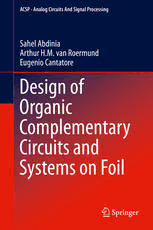Table Of ContentACSP · Analog Circuits And Signal Processing
Sahel Abdinia
Arthur H.M. van Roermund
Eugenio Cantatore
Design of
Organic
Complementary
Circuits and
Systems on Foil
Analog Circuits and Signal Processing
Series editors
Mohammed Ismail
Mohamad Sawan
More information about this series at h ttp://www.springer.com/series/7381
Sahel Abdinia
Arthur H.M. van Roermund
Eugenio Cantatore
Design of Organic
Complementary Circuits
and Systems on Foil
Sahel Abdinia Arthur H.M. van Roermund
Department of Electrical Engineering Department of Electrical Engineering
Eindhoven University of Technology Eindhoven University of Technology
Eindhoven , The Netherlands Eindhoven , The Netherlands
Eugenio Cantatore
Department of Electrical Engineering
Eindhoven University of Technology
Eindhoven , The Netherlands
ISSN 1872-082X ISSN 2197-1854 (electronic)
Analog Circuits and Signal Processing
ISBN 978-3-319-21187-9 ISBN 978-3-319-21188-6 (eBook)
DOI 10.1007/978-3-319-21188-6
Library of Congress Control Number: 2015945937
Springer Cham Heidelberg New York Dordrecht London
© Springer International Publishing Switzerland 2015
T his work is subject to copyright. All rights are reserved by the Publisher, whether the whole or part of
the material is concerned, specifi cally the rights of translation, reprinting, reuse of illustrations, recitation,
broadcasting, reproduction on microfi lms or in any other physical way, and transmission or information
storage and retrieval, electronic adaptation, computer software, or by similar or dissimilar methodology
now known or hereafter developed.
T he use of general descriptive names, registered names, trademarks, service marks, etc. in this publication
does not imply, even in the absence of a specifi c statement, that such names are exempt from the relevant
protective laws and regulations and therefore free for general use.
T he publisher, the authors and the editors are safe to assume that the advice and information in this book
are believed to be true and accurate at the date of publication. Neither the publisher nor the authors or the
editors give a warranty, express or implied, with respect to the material contained herein or for any errors
or omissions that may have been made.
Printed on acid-free paper
S pringer International Publishing AG Switzerland is part of Springer Science+Business Media
(www.springer.com)
Acknowledgements
T he work published in this book was funded in the frame of the European FP7 proj-
ect COSMIC (grant agreement no 247681). The authors would like to thank all the
partners involved in COSMIC for their contributions, including imec/TNO (Leuven,
Belgium), CEA-Liten (Grenoble, France), ST-Microelectronics (Catania, Italy),
Catania University (Catania, Italy), and in particular, Jan Genoe, Gerwin Gelinck,
Kris Myny, T-H Ke from imec/TNO and Isabell Chartier, Stephanie Jacob, Romain
Coppard, and Romain Gwoziecki from CEA-Liten.
v
Contents
1 Introduction ............................................................................................... 1
1.1 Organic Circuits: State of the Art ...................................................... 2
1.1.1 Implemented Applications ..................................................... 2
1.1.2 Challenges and Progress ........................................................ 5
1.2 Role of Complementary Technologies ............................................... 6
1.3 Contributions of This Book................................................................ 7
References ................................................................................................... 9
Part I Complementary OTFT Technology, Modelling,
and Building-Block Design
2 Complementary OTFT Technology ......................................................... 15
2.1 Introduction ........................................................................................ 15
2.2 Sheet-to-Sheet (S2S) Fabrication Process ......................................... 16
2.2.1 S2S General Process Flow ..................................................... 16
2.2.2 Differences Between Gen.1 and Gen.2 Flows ....................... 17
2.2.3 Typical Layout Rules ............................................................. 19
2.3 Wafer-to-Wafer (W2W) Fabrication Process ..................................... 20
2.3.1 Process Flow .......................................................................... 20
2.3.2 Typical Layout Rules ............................................................. 23
2.4 Highlights of the S2S and W2W Technologies ................................. 23
References ................................................................................................... 24
3 OTFT Modelling and Characteristics ..................................................... 27
3.1 Introduction ........................................................................................ 27
3.2 OTFT Operation and Performance .................................................... 28
3.3 Modelling of S2S OTFTs ................................................................... 30
3.3.1 OTFT Model for Gen.1 .......................................................... 32
3.3.2 OTFT Model for Gen.2 .......................................................... 36
3.4 Modelling of W2W OTFTs ................................................................ 40
3.5 Highlights of the S2S and W2W OTFT Characteristics .................... 43
References ................................................................................................... 44
vii
viii Contents
4 Digital Circuit Design ............................................................................... 47
4.1 Introduction ........................................................................................ 47
4.2 Digital Design in S2S Technology ..................................................... 48
4.2.1 Fully Static Blocks ................................................................. 49
4.2.2 Transmission-Gate (TG) Blocks ............................................ 55
4.2.3 Dynamic Blocks ..................................................................... 57
4.2.4 Logic Style Selection ............................................................. 59
4.3 Digital Design in W2W Technology .................................................. 60
4.3.1 Fully Static Blocks ................................................................. 61
4.3.2 Transmission-Gate Blocks ..................................................... 63
4.3.3 Logic Style Selection ............................................................. 63
4.4 Digital Design Highlights .................................................................. 65
References ................................................................................................... 66
5 Analogue and Mixed-Signal Circuit Design ........................................... 69
5.1 Introduction ........................................................................................ 69
5.2 Analogue Design in S2S Technology ................................................ 70
5.2.1 OTAs ...................................................................................... 71
5.2.2 Comparators ........................................................................... 73
5.2.3 DAC ....................................................................................... 79
5.2.4 Rectifi ers ................................................................................ 81
5.2.5 AM Demodulator ................................................................... 87
5.3 W2W OTA ......................................................................................... 89
5.4 Analogue Design Highlights .............................................................. 90
References ................................................................................................... 90
Part II Implemented Systems-on-Foil
6 Display Driver ........................................................................................... 95
6.1 Introduction ........................................................................................ 95
6.2 Line Driver Circuit ............................................................................. 96
6.3 System Test ........................................................................................ 97
6.4 Highlights ........................................................................................... 98
References ................................................................................................... 99
7 Temperature Monitor ............................................................................... 101
7.1 Introduction ........................................................................................ 101
7.2 ADC ................................................................................................... 102
7.3 Sensor ................................................................................................. 106
7.4 System Test ........................................................................................ 109
7.5 Highlights ........................................................................................... 111
References ................................................................................................... 111
Contents ix
8 RFID Tag ................................................................................................... 113
8.1 Introduction ........................................................................................ 113
8.2 RFID Circuits ..................................................................................... 114
8.2.1 Front End ............................................................................... 114
8.2.2 Code-Recognition Unit .......................................................... 117
8.3 Test System Schemes ......................................................................... 118
8.4 Highlights ........................................................................................... 120
References ................................................................................................... 121
9 Conclusions ................................................................................................ 123
References ................................................................................................... 126
Glossary ........................................................................................................... 127

